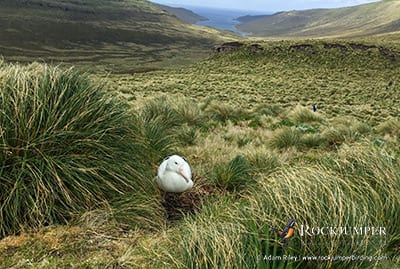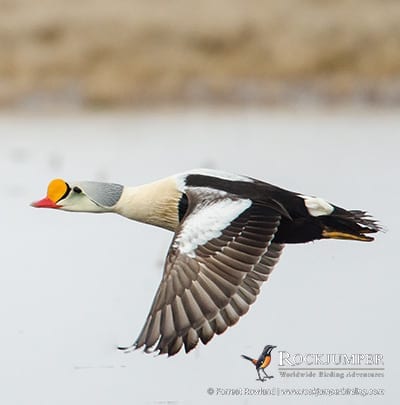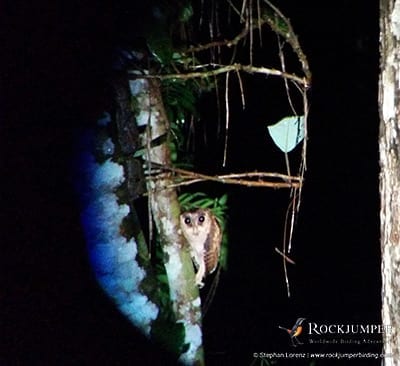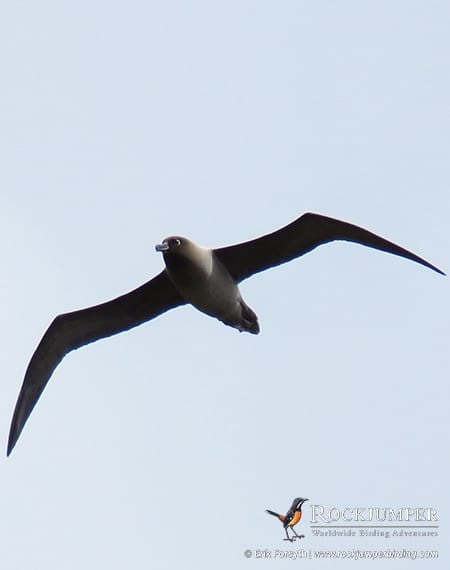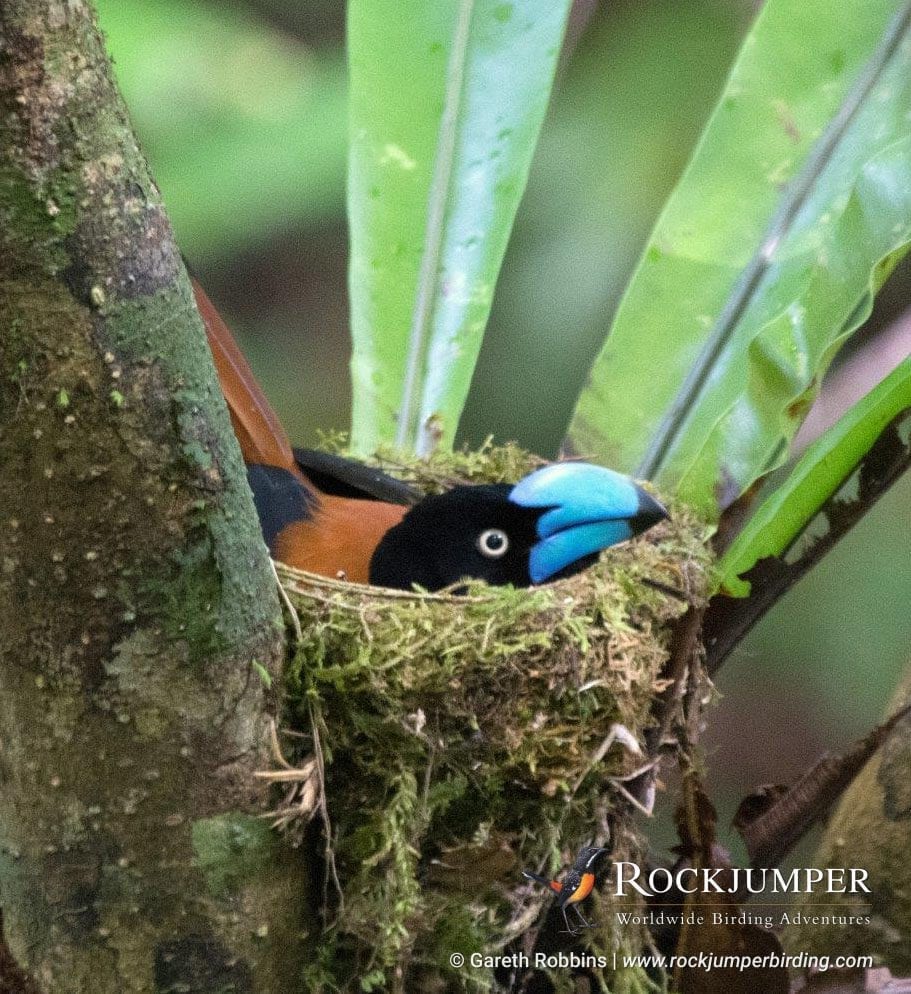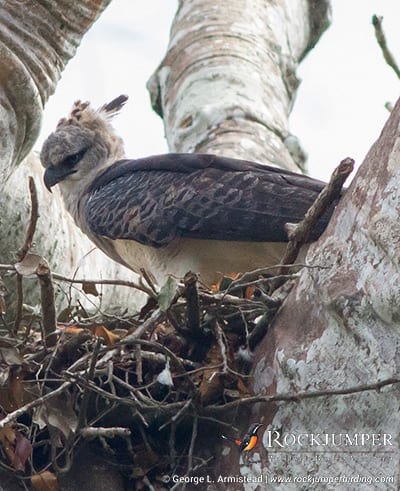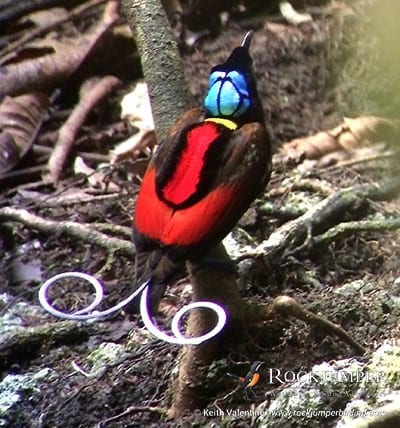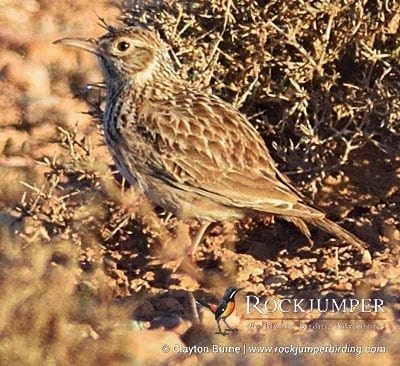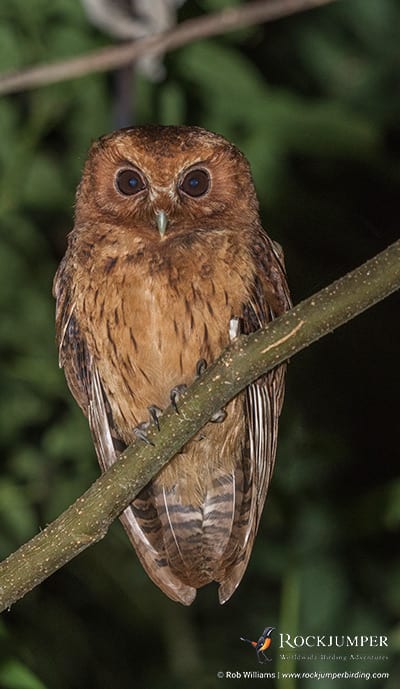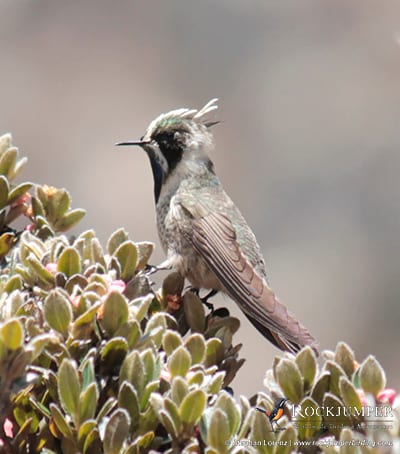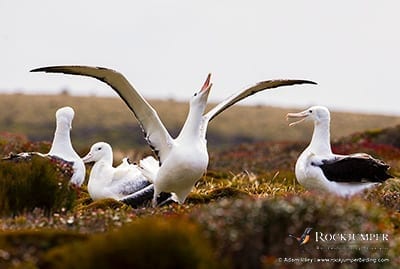
Another great year for birding has flown by, presenting our tour leaders with the difficult task of selecting their top bird out of hundreds and thousands of specials seen in 2017. The rest of us, however, have the pleasure of reading the year’s highlights from our leaders as recorded in their own words.
Adam Riley – Southern Royal Albatross
Forrest Rowland – King Eider
Waterfowl are under-appreciated by most folks. In most cases, the species are fairly widespread and common, even predictable throughout their ranges (with several exceptions of course) and therefore don’t seem to inspire as much emotion and excitement as other birds do. However, the Arctic has some truly spectacular species in the eiders. These ornate ducks inhabit some of the most inhospitable places on planet Earth, and display a hardiness beyond the pale. Alaska is the place to see eiders. This year’s Rockjumper visit to Barrow offered up all four species (Steller’s, Spectacled, Common, and King) in decent numbers. One drake King Eider, in particular, had us all in awe.
This oddly calm individual allowed us to approach uncommonly close, and the photo ops of this elegant species were outrageous. Choosing the “sighting of the year” amongst the 2,500+ species I’ve encountered this year wasn’t easy. But Alaska is dear to my heart, and nothing reminds me more of Alaska than the King Eider.
Rich Lindie – Sri Lanka Bay Owl
I had no trouble in selecting my top sighting of 2017 – Sri Lanka Bay Owl. Not only was this my most-wanted bird in the Indian subcontinent as of a few weeks ago, it was also one of the hardest I’ve had to work for. In a series of events that included two failed attempts, eight days of near-incessant rain, an army of leeches– not to mention several anxious moments in the dark – I finally laid eyes on this beauty, in what can only be described as some eleventh-hour magic! To prove its elusiveness, the only photo we managed to get was by Stephan Lorenz using his phone camera through my binoculars!!!
Erik Forsyth – Light-mantled Sooty Albatross
My bird of the year was a toss-up between two highly desired species: Wallace’s Standard-wing on Halmahera Island, Indonesia; and Light-mantled Albatross – a bird of southern oceans and islands. I had been dreaming of both of these for many years, and both were finally achieved this year.
It was a tough decision, but in the end the Light-mantled Albatross won the prize. We were walking along a cliff edge on Enderby Island, part of the Auckland Island group, when suddenly, a bird appeared 400m away, gliding effortlessly along the cliff and heading directly at us. The views were awesome and all the detail could be absorbed, including the white eye-ring and the delicate plumage features. A few minutes later and the bird alighted on a rocky cliff only 75m away. The views we had were fantastic, and are etched in my mind forever.
Gareth Robbins – Helmet Vanga
Despite guiding in Madagascar several times, I hadn’t had the opportunity to explore the vast lowlands of Masoala National Park, in the remote north-east of this massive island, until this year. Locating the bizarre Aye-aye was amazing, but the real highlight was finding the mythical Helmet Vanga. Arguably the most sought-after bird on Madagascar, an adult was quietly incubating on a nest, and we were fortunate to not have any rain while we watched this bird for close to an hour (from a distance that did not to disturb). The Helmet Vanga was definitely one of the birds I have most wanted to see, so I was thrilled to obtain such great views and at the same time know that the species is successfully breeding in the wild.
George Armistead – Crested Eagle
Imposing and impressive, the Crested Eagle is like a slightly scaled-down version of the massive Harpy Eagle. Seeing a Harpy Eagle is a rare thing and this is surely one of the most sought-after birds in the world, but seeing a Crested Eagle is actually even harder. We managed to see both in Panama in 2017!! While Crested Eagles have been found from Guatemala all the way down to Argentina, this sleek raptor is really rare throughout its rather expansive range. I was fortunate enough to guide two of Rockjumper’s Panama – Darien Extension tours in 2017, and surely my highlight of the year was seeing not just the fierce, regal adult female pictured here, but also an adorable, if wobbly, white little chick in the nest. Relatively few have seen this bird, and fewer still have seen it at an active nest. We were beyond thrilled!
Later, it was disheartening to hear that the nestling seemed to have broken a wing, and disappeared. We all feared it dead. Everyone counted it as a tragic loss. So sad, especially given the rarity of the bird, and the scarcity with which a nest is actually accessible for prolonged observation. But then, suddenly, the youngster shocked everyone, re-appearing at the nest and in perfect health! Apparently, the bird had taken some missteps while exercising its wings around the nest. Out of the nest, these young eagles can look quite awkward, and when it was seen away from the nest, with wings all akimbo, the worst was feared. In the end though, only the nestling’s pride appeared hurt, and its antics were really just the growing pains of an antsy young eagle. Luckily for the eaglet, it had two very attentive parents bringing it tasty meals of iguanas, opossums, squirrels and more. All in all, a very lucky sighting and an epic bird!
Keith Valentine – Wilson’s Bird-of-paradise
The Remote West Papuan Islands Cruise – the name itself exudes thoughts of an exotic, far flung part of the world, brimming with natural treasures, beauty and adventure. As it turns out, this is exactly what the tour delivers, and was rated by many of our fabulous group this year as the best tour they have ever had the pleasure of doing. The voyage is jam-packed full of gorgeous, exotic islands with fabulous names such as Kofiau, Waigeo, Obi and Seram; while the birds are equally as glamorous and mysterious, and include the likes of the mysterious Madanga, Moluccan Woodcock, Kofiau Paradise Kingfisher, Carunculated Fruit Dove, Moluccan Masked Owl, Hantu Boobook, Salmon-crested Cockatoo, Purple-naped Lory and Buru Racket-tail.
These species and many others were undoubted highlights of these incredible Indonesian islands; however, it’s arguably the almost unbelievable birds-of paradise that steal the show. This tour offers exceptional chances at a good variety within the family, and we were thrilled to have magnificent encounters with beauties such as King, Magnificent and the wonderfully-adorned Red Bird-of-paradise. There was, however, one species that came up trumps – the incredible Wilson’s Bird-of-paradise, a species that has often been considered by many birders as one of the most sought-after on our planet. Over the years, the species has ticked many boxes being rare and hardly known, highly localised in distribution, difficult to get to and above all else, simply spectacular to observe! These days a lot more is known about the unique Wilson’s Bird-of-paradise, and while the species is still localised it has become a lot easier to actually find, especially when you are accessing the habitat from a wonderfully appointed Liveaboard (dive boat). For me personally, the entire tour was extremely memorable and an experience I will highly cherish forever.
The year produced a number of other fabulous birds, such as Eared and Rusty-naped Pittas – both species I have spent a long time searching for, Alagoas Antwren – now down to less than 20 birds in the wild, Lear’s Macaw – watching over 200 of these extraordinary birds at their breeding site is without a doubt one of the best birding experiences I have ever had, and finally getting to grips with other exceptional birds like Araripe Manakin, Banded Cotinga, Grey-breasted Parakeet, White-collared Kite and Hooded Visorbearer. All of these species make for extremely worthy contenders for Bird of the Year, but it is Wilson’s Bird-of-paradise that takes the top slot at the end of what has been a seriously exciting and enjoyable year!
Second only to antpittas, larks are my priority bird family. With 28 species in my backyard of southern Africa, this is perhaps not surprising. When the opportunity to co-lead a tour of Morocco in early 2017 presented itself, I jumped at the prospect of re-visiting this amazing country, and more importantly, the possibility of seeing up to 13 species of lark in less than 10 days.
Just before I flew across Africa to start the tour, I revelled in explaining to our office staff about just how excited I was to go in search of Dupont’s Lark – brown, dull, unremarkable and very rare. I proclaimed it would be my Bird of the Year should we all be lucky enough to find it.
Half way through the tour, we already had 11 of the likely lark species in the bag – all of which had presented and showed incredibly well. Maghreb Lark was essentially a formality in the last few days of the tour. This left Dupont’s Lark. It is considered one of the most difficult birds to see in the entire Western Palearctic, and also one that causes an unusual amount of discomfort. Most larks inhabit dry and desolate habitats, where you are more prone to getting a sunburnt when tracking them down. While Dupont’s inhabits a similarly desolate environment, the bird is only reliably seen at first light, when the temperature is sub-zero!
We exited the vehicle near the Zaida Plains, pitch black with little more than moonlit views of the nearby snow-covered High Atlas – conditions were as frigid as expected! As the first rays of light emanated over the horizon, the distinctive call of a few Dupont’s could be heard. The initial relief of hearing them soon dissipated with the realisation that seeing these skulkers was quite another matter. Much running around and gnashing of teeth ensued before we chanced upon an individual. Seemingly unaware of our presence, we had at least 25 minutes of uninterrupted observation of an individual as it went about its morning business of digging in the sand, scuttling from one bush to another and occasionally standing atop a piece of scrub to observe its surroundings.
I wouldn’t mind predicting my bird of 2018: perhaps a Shoebill or a half-dozen antpittas…
Wayne Jones – Taita Falcon
The Abel Erasmus Pass near the western border of Kruger National Park was renowned as THE spot to see Taita Falcon (the rarest falcon in Africa) in South Africa. Being stuck on the other side of the country, I never got around to visiting the site. When I started guiding for Rockjumper five years ago I thought I’d finally have an opportunity to see the birds, but my employment coincided with the falcon pair’s apparent relocation! Just before my South Africa Mega in October this year, I received word that the falcons were back. We stopped there on our tour and within five minutes found the pair streaking along the cliffs above us. They are the most incredible flyers, slicing through the air like tiny supersonic jets without a single wingflap! Hopefully, their residency is once again permanent so we can view them on many more upcoming tours.
*this bird is difficult to photograph…see attached efforts.
Taita Falcons by Wayne Jones
Rob Williams – Cinnamon Screech Owl
It was our second night looking for Cinnamon Screech Owl during Rockjumper’s Northern Peru tour. The previous evening, we had heard it calling at dusk and lured it closer but, just as we had located it, a group of Andean Night Monkeys – a rare and threatened species we were somewhat delighted to see – had crashed through the bamboo patch where it was calling and the owl had relocated into an inaccessible area further up the ridge. Staying there, taunting us with occasional calls. On the second night, we heard no spontaneous calls at dusk, but some quiet playback got a response and the bird approached quickly, perching right over the trail. It was so close we had to back away to be able to focus on it. It remained calling quietly for a couple of minutes before we left it in peace. Certainly the best view I have ever had of this rare and local cloud-forest owl, and undoubtedly my birding highlight of the year. You know this owl must be a good one to come out on top on a tour that had recorded 15 species of owl, including the infamous Long-whiskered Owlet, endemic Koepcke’s Screech Owl and a displaying male Stygian Owl.
Stephan Lorenz – Blue-bearded Helmetcrest
Early this year, I was fortunate enough to complete a 6-day trek in a remote section of the Santa Marta Mountains of northern Colombia. The aim of the adventure was to reach high elevations to seek the endemic and critically endangered Blue-bearded Helmetcrest and Santa Marta Wren – both having been recently rediscovered. It took two full days of hiking before we reached 3,800m asl, and the remnant vegetation around a set of lagoons where both species have been sighted during previous treks. It didn’t take long, and during the first evening I spotted a female Blue-bearded Helmetcrest right before sunset. The following day, we spent several hours searching for the hummingbird and staked out one of a few flowering bushes.
After a two-hour wait, a male Blue-bearded Helmetcrest arrived to feed just a few metres away. The Santa Marta Wren proved to be numerous and easily seen. Unfortunately, both species remain critically endangered due habitat loss, and it was a privilege for me to see them. The entire journey into what are some of the most beautiful mountains in the world, and the excellent sighting of this rare and stunning hummingbird make it the bird of the year for me.
Birds so elusive we couldn't even get pictures
David Hoddinott – Udzungwa Forest Partridge
In October, we enjoyed another fabulous adventure through the Eastern Arc Mountains of Tanzania during Rockjumper’s Tanzania Mega tour. After having completed this expedition on two previous occasions without success in finding the near-mythical Udzungwa Forest Partridge, I didn’t hold up much hope in seeing it. This year, we tried a new area in the West Udzungwa Mountains, and after an hour with no sign of it we suddenly heard one calling on a slope below us. We positioned ourselves as best we could and then tried to entice it a little closer. It seemed to come closer; however, after a lengthy wait, we were unsuccessful in our attempts to see it – although it probably saw us. Dejected, we headed back to the main trail. As we reached it, we heard another calling down the opposite slope. This area had a more open understorey, and once again we hoped to see this rare, relict species. Again, we positioned ourselves in an area where we thought we’d have our best chance of catching a glimpse of this shy and elusive bird. After some time, I spotted the bright orange bill of the male in the gloomy understorey, and he showed well for some, but all too briefly. Later, whilst walking another trail we found another, and this time everyone in our group enjoyed good views. Elated, we headed back to camp where we enjoyed a few cold ones to celebrate seeing this fabulous partridge. Only a select few birders have ever seen it, and so we counted ourselves very fortunate. What a cracker!!!
Glen Valentine – Lyre-tailed Honeyguide
What an amazing year 2017 has been for rarities and quality birds of epic proportions, which made this a very challenging decision.
Species that made my shortlist included Mountain Peacock-Pheasant, Firethroat, Plumed Guineafowl, Principe Thrush, African River Martin and Red-breasted Paradise Kingfisher; but, in the end, it was the Lyre-tailed Honeyguide that made it to number one.
Honeyguides as a family are intriguing, with most of the seventeen representatives – fifteen in Africa and two in Asia – being extremely scarce and difficult to find. However, the honeyguide family’s most desired and sought-after representative is undoubtedly the Lyre-tailed Honeyguide. Often hailed as one of Africa’s “Holy Grail Birds” and one of “the World’s Top 50 Birds to See”, it is a species that is still extremely little-known and seldom-encountered. If one does have the opportunity to venture into its limited and seldom-visited range in the remote and extensive rainforests of Gabon, Cameroon or Sierra Leone at the right time of year, your chances of hearing one are fairly good. However, seeing this near-mythical creature is another achievement altogether! The adult males perform a unique display flight whereby they propel themselves high over the high forest canopy while making the most outrageous, steadily rising call – arguments still rage about whether this is a mechanical sound generated by their wings or their bizarrely shaped tails; and then, as the sound reaches its peak volume, they zoom back to their usually-concealed perch in the forest canopy.
During our August tour of Gabon, we were extremely fortunate to obtain simply magical flight views of this species in full display, as well as perched scope views in Lope National Park. A simply mind-blowing experience and one that we will all cherish forever!
